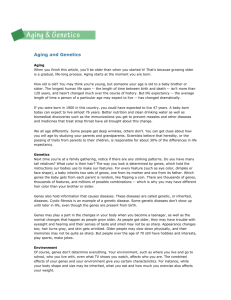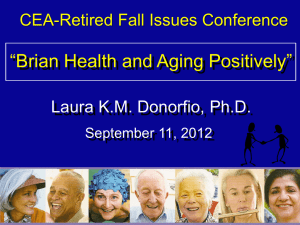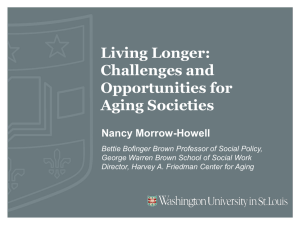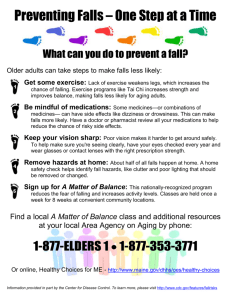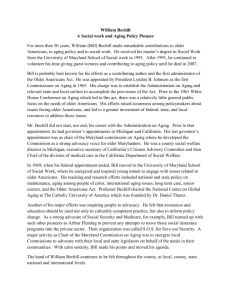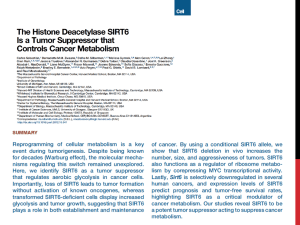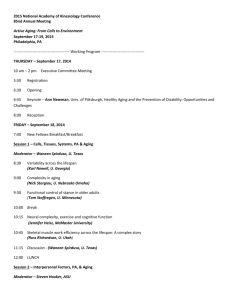Can We Stay Young
advertisement
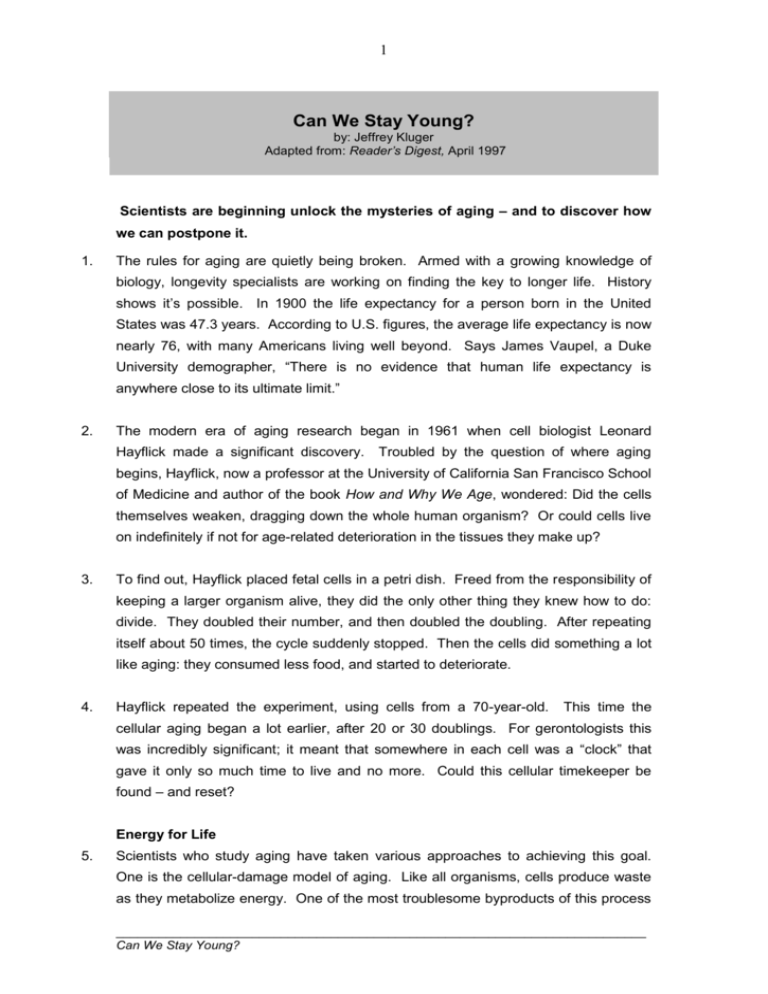
1 Can We Stay Young? by: Jeffrey Kluger Adapted from: Reader’s Digest, April 1997 Scientists are beginning unlock the mysteries of aging – and to discover how we can postpone it. 1. The rules for aging are quietly being broken. Armed with a growing knowledge of biology, longevity specialists are working on finding the key to longer life. History shows it’s possible. In 1900 the life expectancy for a person born in the United States was 47.3 years. According to U.S. figures, the average life expectancy is now nearly 76, with many Americans living well beyond. Says James Vaupel, a Duke University demographer, “There is no evidence that human life expectancy is anywhere close to its ultimate limit.” 2. The modern era of aging research began in 1961 when cell biologist Leonard Hayflick made a significant discovery. Troubled by the question of where aging begins, Hayflick, now a professor at the University of California San Francisco School of Medicine and author of the book How and Why We Age, wondered: Did the cells themselves weaken, dragging down the whole human organism? Or could cells live on indefinitely if not for age-related deterioration in the tissues they make up? 3. To find out, Hayflick placed fetal cells in a petri dish. Freed from the responsibility of keeping a larger organism alive, they did the only other thing they knew how to do: divide. They doubled their number, and then doubled the doubling. After repeating itself about 50 times, the cycle suddenly stopped. Then the cells did something a lot like aging: they consumed less food, and started to deteriorate. 4. Hayflick repeated the experiment, using cells from a 70-year-old. This time the cellular aging began a lot earlier, after 20 or 30 doublings. For gerontologists this was incredibly significant; it meant that somewhere in each cell was a “clock” that gave it only so much time to live and no more. Could this cellular timekeeper be found – and reset? Energy for Life 5. Scientists who study aging have taken various approaches to achieving this goal. One is the cellular-damage model of aging. Like all organisms, cells produce waste as they metabolize energy. One of the most troublesome byproducts of this process __________________________________________________________________________ Can We Stay Young? 2 is a free radical, an ordinary oxygen molecule with an extra electron. The molecule seeks to correct this electrical imbalance by moving about, trying to bond with other molecules. A lifetime of this can damage cells, leading to a range of disorders from cancer to more general symptoms of aging such as wrinkles and arthritis. 6. In recent years some nutritionists have advocated diets high in fruits and vegetables containing antioxidants – substances that are believed to absorb free radicals and carry them out of the body. But antioxidants have an uneven record. In some studies they seem to be associated with a dramatic reduction in cancer or other diseases; in other studies, an increase. In either case, few contemporary aging researchers think self-medicating at a salad bar can significantly extend the human life-span. 7. Far more promising might be new research into another byproduct of cellular metabolism: glycosylation – or what cooks call browning. When foods such as turkey, bread and caramel are heated, proteins bind with sugars, causing the surface to darken and turn soft and sticky. In the 1970s biochemists hypothesized that the same reaction might occur in people suffering from diabetes. When sugars and proteins bond, they attract other proteins, which form a sticky, weblike network that could stiffen joints, block arteries, and cloud clear tissues such as the lens of the eye, leading to cataracts. Diabetics suffer from all these ailments. 8. But so do the aged. Was it possible that as the cells of nondiabetics metabolize sugars, the same glycosylation might take place, only much slower? Studies seemed to say yes. 9. The sticky glycosylation residue has been given an appropriate acronym: AGE, for advanced glycosylation end products. Investigators at the Picower Institute for Medical Research in Manhasset, N.Y., are working on a drug, pimagedine, that works to dissolve the connection between AGE and the proteins around it. Essentially, it helps unstick what AGE glues together. No-Fat Centenarians 10. An alternative to changing the way cells process nutrients is to give them less to process in the first place. Studies have shown that rats whose caloric intake is 30 to 40 percent lower than that of a control group tend to live up to 40 percent longer. For a man, that would translate to a diet of just about 1500 calories a day – in exchange for 30 extra years of life. __________________________________________________________________________ Can We Stay Young? 3 11. Just how this business of swapping food for time works is not entirely clear, but George Roth, molecular physiologist with the National Institute on Aging, has some ideas. When calories are restricted, Roth explains, body temperature drops about 1.8 degrees Fahrenheit. Lower temperature means a less vigorous metabolism, which means less food is processed. “The animals switch from a growth mode to a survival mode,” Roth says. “They get fewer calories, so they burn fewer. I think caloric restriction could take us well beyond a life-span of 80,” he adds. “After all, you rarely see a fat centenarian.” 12. In a nation of consumers for whom caloric restrictions can mean a smaller serving of french fries with their double burgers, it may be more realistic to imitate the caloric restriction pharmacologically. “Essentially,” explains Roth, “we’d use a pill to trick a cell into thinking less food is coming in.” 13. But caloric reduction is essentially maintenance work: little more than repairing holes in a sinking ship. What some researchers really want is to get down into the body’s engine room – the genes themselves – and rebuild things from the genes up. Remarkably, it appears there may be a way. Superworms 14. Some genes implicated in aging have already been identified. Nematodes in Siegfried Hekimi’s genetics lab at McGill University in Montreal have been known to survive up to 75 days. Outside the lab, the tiny, transparent worms barely last nine. 15. Hekimi created his little superworms by breeding long-lived individuals, thus extending the life-spans of the next generation. He then searched the animals’ chromosomes until he found the mutated gene that was responsible, a gene he called Clock-1. When Hekimi went looking for similar clock genes in people, he found one so similar, he says, “that it’s possible the whole clock system works the same way. If we find all of the human clock genes, we can perhaps slow them down just a little, so we can extend life expectancy just a little.” 16. The problem is the large number of genes involved. Geneticist George Martin at the University of Washington in Seattle believes that even if only a few master-clock genes directly guide aging in humans, up to 7000 more might be peripherally involved. Re-engineering even one is an extremely complex process. Re- engineering all 7000 would be impossible. __________________________________________________________________________ Can We Stay Young? 4 17. While the genes involved in the aging process can’t yet be manipulated, many researchers are using what they’ve learned about aging to attack disease. For example, investigators are looking into using the AGE drug pimagedine to help clear arteries and improve cardiac health, adding 13.9 years to average national life expectancy. 18. Researchers believe there’s no reason many adults won’t one day live to see 120. For people dreaming of immortality, that prospect may fall a little short. But for most people, four or five additional decades sounds like a wonderful first step. (1200 words) __________________________________________________________________________ Can We Stay Young?
